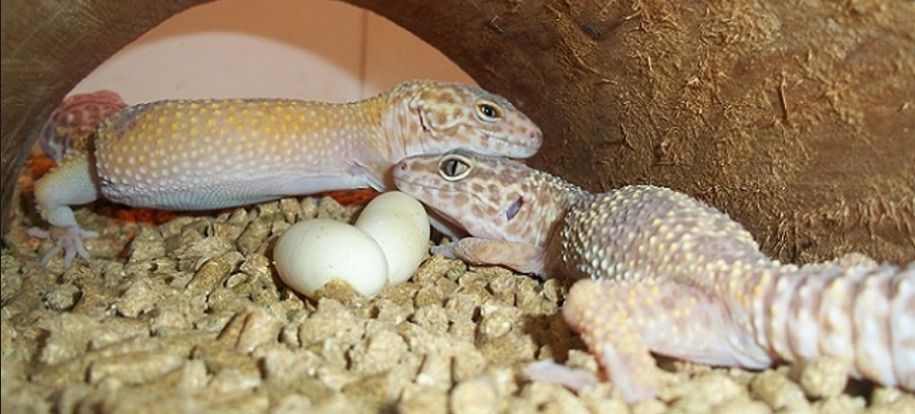Leopard geckos are one of the most popular pet reptiles kept in captivity. These docile lizards are relatively easy to care for and have interesting reproductive behaviors. One common question leopard gecko owners ask is, “How many eggs do leopard geckos lay?” Let’s explore the answer in detail.
Typical Clutch Size
In the wild, leopard geckos are solitary animals that only come together to mate. The breeding season usually occurs in the early spring, after brumation. Brumation is similar to hibernation in mammals, where leopard geckos become less active and eat less during the winter months.
After mating, the female leopard gecko will develop and lay a clutch of two eggs every 15-28 days. She can produce multiple clutches in one breeding season. On average, leopard geckos lay between 6-8 eggs per breeding season, though 10-12 is not uncommon.
In captivity, leopard geckos may produce slightly larger clutch sizes since they can mate more frequently than in the wild. Well-cared for females can lay up to 15-20 eggs per season. However, this is not recommended as it can be stressful on the female’s body. Breeders should allow proper rest periods between breeding cycles.
Factors That Influence Clutch Size

Several factors can influence the number of eggs a female leopard gecko produces:
- Age – Younger females 1-2 years old will lay smaller clutches of 2-5 eggs. Older females 3+ years lay larger clutches of 6-10 eggs.
- Size – Larger, heavier females tend to produce more eggs than smaller females.
- Nutrition – Ensuring the female leopard gecko is fed a nutritious diet with proper calcium and vitamins helps maximize egg production.
- Brumation – Cycles of brumation help trigger breeding behavior. Leopard geckos that skip brumation may produce fewer eggs.
- Male stimuli – Having a healthy male present to stimulate breeding behaviors can help encourage females to develop and lay larger clutches.
- Genetics – Some bloodlines are predisposed to producing larger clutch sizes each season. Selective breeding can increase this trait.
Caring for Gravid (Egg-Carrying) Females
Once a female leopard gecko is confirmed to be developing eggs, there are some special care considerations:
- Provide a suitable nesting area with a lay box of moist vermiculite or eco earth. This helps encourage egg-laying.
- Boost calcium intake by dusting feeder insects more frequently, or provide a small dish of powdered calcium in the tank. This supports egg shell development.
- Monitor weight and appetite closely. Egg-heavy females may need support if they stop eating as much.
- Limit handling and provide plenty of quiet rest. Too much stress can cause egg binding or reabsorption.
- Watch for signs of straining, lethargy, or a lumpy belly indicating egg binding. This requires veterinary assistance.
Can Leopard Geckos Reabsorb Eggs?
Yes, if conditions are not ideal, female leopard geckos can reabsorb some or all of their eggs to conserve resources. This most often occurs due to:
- Lack of suitable nesting sites
- Disruption from other geckos in the same tank
- Excessive handling or stress
- Poor nutrition leading up to breeding season
- Abnormal temperatures in the tank
- Physical health problems in the female
Egg reabsorption is not ideal, but is a natural survival mechanism when circumstances prevent successful egg laying. Addressing the underlying issues can help avoid reabsorption in the future.
How Many Eggs Do Leopard Gecko Lay?
On average, female leopard geckos can lay between 6-10 eggs per breeding season, with larger clutches of 15-20 possible but not recommended. Clutch size is influenced by the female’s age, size, nutrition, health, and environment. With excellent care, most will have no trouble laying healthy clutches each breeding cycle. Be sure to monitor gravid females closely and provide everything needed for successful egg development and laying.
FAQs
Can a female leopard gecko lay multiple clutches of eggs in one breeding season?
Yes, female leopard geckos can lay multiple clutches of eggs in a single breeding season. They are capable of producing several clutches, usually spaced a few weeks apart, if they are well-fed, healthy, and conditions are suitable.
What should I do if I find eggs in my leopard gecko’s enclosure?
If you find eggs in your leopard gecko’s enclosure, carefully remove them and place them in an incubator if you intend to hatch them. Ensure the eggs are oriented as found, maintain proper incubation conditions, and monitor them closely until they hatch or consult a reptile expert for guidance.
How long does it take for leopard gecko eggs to hatch, and what is the hatching success rate?
Leopard gecko eggs typically take around 45 to 60 days to hatch, depending on temperature and humidity. The hatching success rate can vary but is generally high if incubation conditions are optimal. It’s essential to maintain stable conditions for successful hatching.
Are there any special care requirements for leopard gecko eggs and hatchlings?
Leopard gecko eggs and hatchlings require consistent temperature and humidity in an incubator. Once hatched, the hatchlings need appropriate enclosures, correct diet, and supplements to ensure their health and growth. Providing proper hiding spots and gentle handling is crucial for their well-being.
Can you provide tips for breeding leopard geckos and maximizing egg production?
To maximize egg production in leopard geckos, ensure they have adequate nutrition, proper temperature, and humidity during the breeding season. Monitor their behavior for signs of receptivity, and introduce males to females when receptive. Keep detailed breeding records, and consult experienced breeders or reptile experts for guidance.



